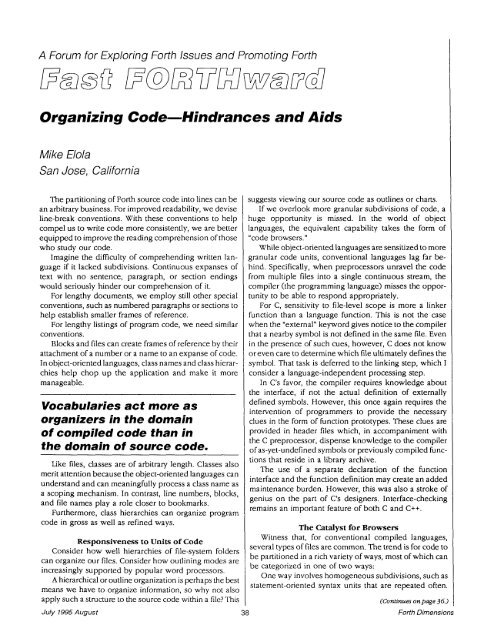2 - Forth Interest Group
2 - Forth Interest Group
2 - Forth Interest Group
Create successful ePaper yourself
Turn your PDF publications into a flip-book with our unique Google optimized e-Paper software.
A Forum for Exploring <strong>Forth</strong> Issues and Promoting <strong>Forth</strong><br />
Organizing Code-Hindrances and Aids<br />
Mike Nola<br />
San Jose, California<br />
The partitioning of <strong>Forth</strong> source code into lines can be<br />
an arbitrary business. For improved readability, we devise<br />
line-break conventions. With these conventions to help<br />
compel us to write code more consistently, we are better<br />
equipped to improve the reading comprehension of those<br />
who study our code.<br />
Imagine the difficulty of comprehending written lan-<br />
guage if it lacked subdivisions. Continuous expanses of<br />
text with no sentence, paragraph, or section endings<br />
would seriously hinder our comprehension of it.<br />
For lengthy documents, we employ still other special<br />
conventions, such as numbered paragraphs or sections to<br />
help establish smaller frames of reference.<br />
For lengthy listings of program code, we need similar<br />
conventions.<br />
Blocks and files can create frames of reference by their<br />
attachment of a number or a name to an expanse of code.<br />
In object-oriented languages, class names and class hierar-<br />
chies help chop up the application and make it more<br />
manageable.<br />
Vocabularies act more as<br />
organizers in the domain<br />
of compiled code than in<br />
the domain of source code.<br />
Like files, classes are of arbitrary length. Classes also<br />
merit attention because the object-oriented languages can<br />
understand and can meaningfully process a class name as<br />
a scoping mechanism. In contrast, line numbers, blocks,<br />
and file names play a role closer to bookmarks.<br />
Furthermore, class hierarchies can organize program<br />
code in gross as well as refined ways.<br />
Responsiveness to Units of Code<br />
Consider how well hierarchies of file-system folders<br />
can organize our files. Consider how outlining modes are<br />
increasingly supported by popular word processors.<br />
A hierarchical or outline organization is perhaps the best<br />
means we have to organize information, so why not also<br />
apply such a structure to the source code within a file?This 1<br />
July 1995 August 38<br />
suggests viewing our source code as outlines or charts.<br />
If we overlook more granular subdivisions of code, a<br />
huge opportunity is missed. In the world of object<br />
languages, the equivalent capability takes the form of<br />
"code browsers."<br />
While object-oriented languages are sensitized to more<br />
granular code units, conventional languages lag far be-<br />
hind. Specifically, when preprocessors unravel the code<br />
from multiple files into a single continuous stream, the<br />
compiler (the programming language) misses the oppor-<br />
tunity to be able to respond appropriately.<br />
For C, sensitivity to file-level scope is more a linker<br />
function than a language function. This is not the case<br />
when the "external" keyword gives notice to the compiler<br />
that a nearby symbol is not defined in the same file. Even<br />
in the presence of such cues, however, C does not know<br />
or even care to determine which file ultimately defines the<br />
symbol. That task is deferred to the linking step, which I<br />
consider a language-independent processing step.<br />
In C's favor, the compiler requires knowledge about<br />
the interface, if not the actual definition of externally<br />
defined symbols. However, this once again requires the<br />
intervention of programmers to provide the necessary<br />
clues in the form of function prototypes. These clues are<br />
provided in header files which, in accompaniment with<br />
the C preprocessor, dispense knowledge to the compiler<br />
of as-yet-undefined symbols or previously compiled func-<br />
tions that reside in a library archive.<br />
The use of a separate declaration of the function<br />
interface and the function definition may create an added<br />
maintenance burden. However, this was also a stroke of<br />
genius on the part of C's designers. Interface-checking<br />
remains an important feature of both C and C++.<br />
1 The Catalyst for Browsers<br />
Witness that, for conventional compiled languages,<br />
several types of files are common. The trend is for code to<br />
be partitioned in a rich variety of ways, most of which can<br />
be categorized in one of two ways:<br />
One way involves homogeneous subdivisions, such as<br />
statement-oriented syntax units that are repeated often.<br />
(Continues on page 36.) I<br />
<strong>Forth</strong> Dimensions
















